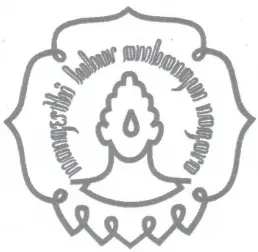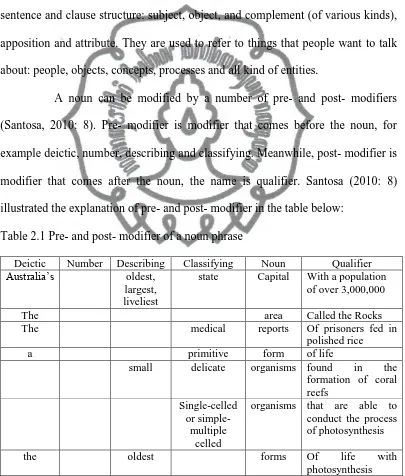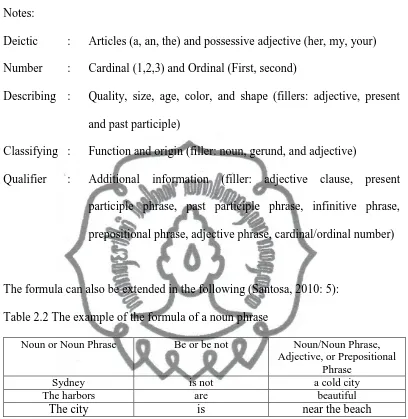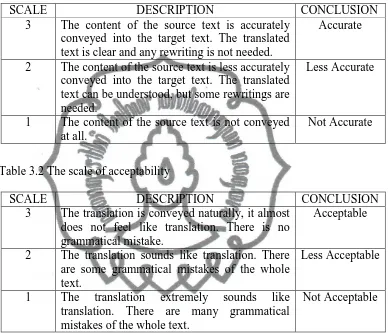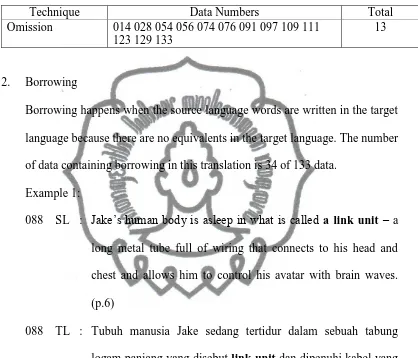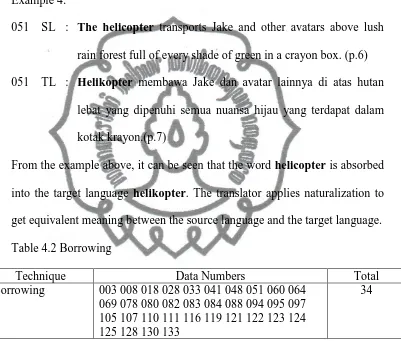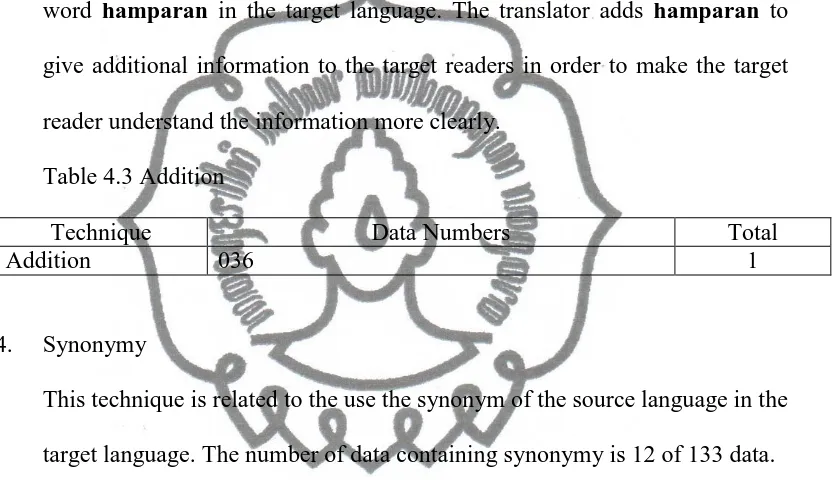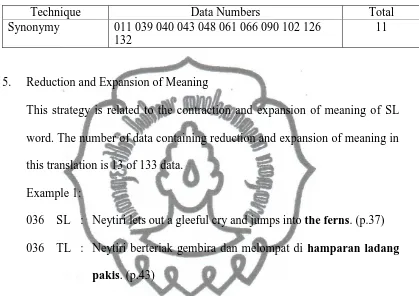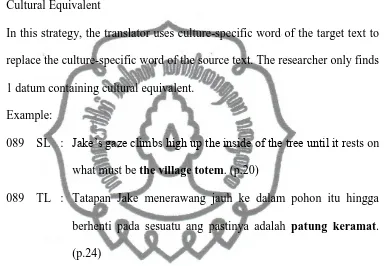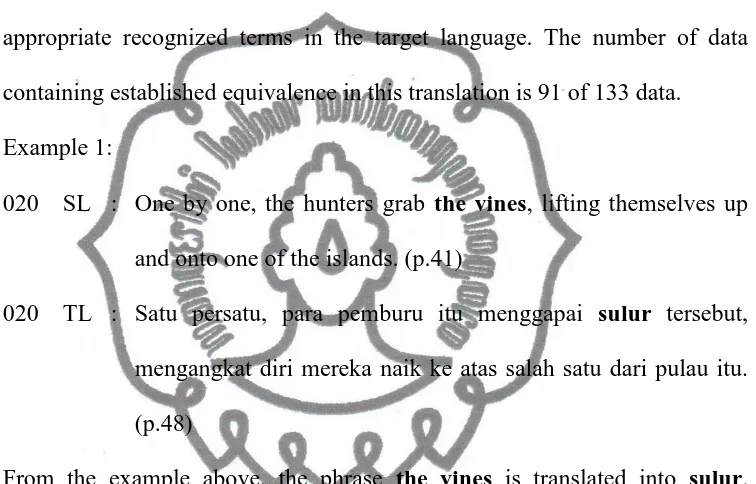commit to user
i
AN ANALYSIS OF TRANSLATION TECHNIQUES
OF NOUN PHRASE AND THE QUALITY OF THE
TRANSLATION IN JAMES CAMERON’S NOVEL
“AVATAR”
THESIS
Submitted as a Partial Fulfillment of Requirement for Sarjana Degree in English Department
By:
Virati Retno Devanti C1306022
ENGLISH DEPARTMENT PROGRAM FACULTY OF LETTERS AND FINE ARTS
SEBELAS MARET UNIVERSITY SURAKARTA
commit to user
commit to user
commit to user
iv
PRONOUNCEMENT
Name : Virati Retno Devanti
NIM : C1306022
It is stated wholeheartedly that this thesis entitled AN ANALYSIS OF
TRANSLATION TECHNIQUES OF NOUN PHRASE AND THE QUALITY OF THE TRANSLATION IN JAMES CAMERON’S NOVEL
“AVATAR” is originally made by the researcher. The things related to other
people’s work are written in italic form or quotation and included within the
bibliography. If this statement is later proven false, the researcher willingly takes
any responsibilities from English Department Faculty of Letters and Fine Arts
Sebelas Maret University.
Surakarta, 2012
The researcher
commit to user
v MOTTO
Be joyful in hope, patient in trouble, and persistent in prayer. (Romans
12:12)
I can do all things through Him who strengthens me. (Philippians 4:13)
commit to user
vi
DEDICATION
I dedicate this thesis to:
My Jesus Christ
My Beloved Parents
My Beloved Sisters
My Beloved Nephews
commit to user
vii
ACKNOWLEDGEMENT
I, as the researcher, would like to thank Jesus Christ for the
accomplishment of this thesis. Working on this thesis is really a hard struggle, but
by His blessing, guidance and love, I can finally complete the thesis. I also would
like to express my gratitude to many persons for the helps, suggestions and
supports during the making of this thesis.
1. Drs. Riyadi Santosa, M.Ed., Ph.D., the Dean of Faculty of Letters and Fine
Arts, Sebelas Maret University for approving this thesis.
2. Drs. Sugiyarto Budi Waskito, M.Pd., the Head of Non-Regular of English
Department for the encouragement in starting and doing this thesis.
3. A huge of thank is dedicated to my Thesis Consultant, Drs. Sugiyarto Budi
Waskito, M.Pd., for his continuous, valuable guidance, advice and
encouragement in completing this thesis. Thanks for being patient to guide
me in accomplishing this thesis.
4. All lectures and staffs in English Department Sebelas Maret University who
have taught, motivated and given guidance during writing this thesis.
5. My parents, (Alm) M. Alfiadi and Emilia Tatiek Yovita, for the love,
support and prayer anytime and anywhere. I always miss you, dad.
6. My sisters, Olivia Shita P. and Pusparuri Prabawanti and also my nephews
Marcellino Ryuga R.P. and Benedicta Lovine E.D.
commit to user
viii
8. Everyone, whom I cannot mention one by one, thanks for the help in
accomplishing this thesis.
I realize that this thesis is far from being perfect. For this, I welcome
any suggestions and criticisms. Hopefully, this can be useful for all readers.
Surakarta, 2012
commit to user
ix
TABLE OF CONTENTS
Page
TITLE ... i
APPROVAL OF THESIS CONSULTANT ... ii
APPROVAL OF THE BOARDS OF EXAMINERS ... iii
PRONOUNCEMENT ... iv
MOTTO ... v
DEDICATION ... vi
ACKNOWLEDGEMENT ... vii
TABLE OF CONTENTS ... ix
LIST OF TABLES ... xi
LIST OF APPENDICES ... xii
ABSTRACT ... xiv
CHAPTER I INTRODUCTION ... 1
A. Research Background... 1
B. Research Limitation ... 3
C. Research Problems ... 3
D. Research Objectives ... 4
E. Research Benefits ... 4
F. Thesis Organization ... 5
CHAPTER II LITERATURE REVIEW ... 6
commit to user
x
B. Translation Process ... 7
C. Translation Techniques ... 9
D. Translation Quality... 14
E. Noun Phrase ... 15
CHAPTER III RESEARCH METHODOLOGY ... 22
A. Research Method ... 22
B. Data and Source of Data ... 22
C. Technique of Data Collection ... 24
D. Technique of Data Analysis ... 25
E. Research Procedure ... 26
CHAPTER IV DATA ANALYSIS ... 27
A. Translation Techniques ... 27
B. Translation Accuracy and Acceptability ... 37
C. Discussion ... 48
CHAPTER V CONCLUSION AND RECOMMENDATION ... 52
A. Conclusion ... 52
B. Recommendation... 53
BIBLIOGRAPHY ... xv
commit to user
xi
LIST OF TABLES
Page
Table 2.1 Pre- and post modifier of a noun phrase ... 16
Table 2.2 The example of the formula of a noun phrase... 17
Table 2.3 The types of post- modifier of a noun phrase ... 17
Table 3.1 The scale of accuracy ... 25
Table 3.2 The scale of acceptability ... 25
Table 4.1 Omission ... 29
Table 4.2 Borrowing ... 31
Table 4.3 Addition ... 32
Table 4.4 Synonymy ... 33
Table 4.5 Reduction and expansion of meaning ... 34
Table 4.6 Cultural equivalent ... 35
Table 4.7 Established Equivalence... 37
Table 4.8 The score of accuracy... 38
Table 4.9 Table of accuracy ... 43
Table 4.10 The score of acceptable ... 44
commit to user
xii
LIST OF APPENDICES
Page
Table 1 Noun phrase consisting of deictic and noun ... 1
Table 2 Noun phrase consisting of deictic, describing and noun ... 2
Table 3 Noun phrase consisting of describing and noun ... 2
Table 4 Noun phrase consisting of deictic, number, describing and noun... 3
Table 5 Noun phrase consisting of classifying and noun ... 3
Table 6 Noun phrase consisting of deictic, classifying and noun ... 3
Table 7 Noun phrase consisting of deictic, number and noun ... 4
Table 8 Noun phrase consisting of deictic, describing, classifying and noun 4 Table 9 Noun phrase consisting of number and noun ... 4
Table 10 Noun phrase consisting of describing, classifying and noun ... 4
Table 11 Noun phrase consisting of noun and qualifier... 4
Table 12 Noun phrase consisting of deictic, noun and qualifier ... 5
Table 13 Noun phrase consisting of classifying, noun and qualifier ... 5
Table 14 Noun phrase consisting of deictic, describing, noun and qualifier ... 5
Table 15 Noun phrase consisting of deictic, describing, classifying, noun and qualifier ... 6
Table 16 Noun phrase consisting of deictic, classifier, noun and qualifier ... 6
Table 17 Noun phrase consisting of deictic, number, classifying and noun .... 6
Table 18 Noun phrase consisting of describing, noun and qualifier ... 6
commit to user
xiii
Table 20 Noun phrase consisting of describing, classifying, noun and
qualifier ... 7
Rater ... 8
commit to user LETTERS AND FINE ARTS. SEBELAS MARET UNIVERSITY.
This research focuses on the analysis of translation techniques and the quality of the translation in terms of accuracy and acceptability of the message of the noun phrases in James Cameron’s novel “Avatar” which has been conveyed by the translator from the source language into the target language.
This is a descriptive qualitative research. This research aims at describing the translation of noun phrases in James Cameron’s novel “Avatar”. There are two kinds of data in this research. The first data are all the noun phrases found in the novel and their translation and the second are the scores collected from the informants.
This research belongs to descriptive study and applies qualitative method. To collect the data, total sampling technique was applied.
The result of the analysis shows that there are 133 noun phrases found in the novel. In this study, the translator employs techniques of translation by omission (13 data or 7.93%), borrowing (34 data or 20.73%), addition (1 datum or 0.61%), synonymy (11 data or 6.70%), reduction and expansion of meaning (13 data or 7.93%), cultural equivalent (1 datum or 0.61%) and established equivalence (91 data or 55.49%). The most frequently used technique is translation by established equivalence which covers 91 data (55.49% of all the data).
The accuracy level of the translation is high. There are 107 data (80.5%) considered to be accurate translation, 23 data (17.3%) considered to be less accurate translation and 3 data (2.2%) considered to be not accurate translation.
The technique of translation by established equivalence is the technique which has high level of accuracy.
The degree of acceptability of the noun phrase translation in Avatar novel is high. There are 110 data (82.7%) considered to be acceptable translation and 23 data (17.3%) classified as less acceptable translation.
The technique of translation by established equivalence is the technique which has high level of acceptability.
AN ANALYSIS OF TRANSLATION
TECHNIQUES OF NOUN PHRASE AND THE QUALITY OF THE TRANSLATION IN JAMES CAMERON’S
NOVEL “AVATAR”
This research focuses on the analysis of translation techniques and the quality of the translation in terms of accuracy and acceptability of the message of the noun phrases in James Cameron’s novel
“Avatar” which has been conveyed by the translator from the
source language into the target language.
This is a descriptive qualitative research. This research aims at describing the translation of noun phrases in James Cameron’s
novel “Avatar”. There are two kinds of data in this research. The
first data are all the noun phrases found in the novel and their translation and the second are the scores collected from the informants.
This research belongs to descriptive study and applies qualitative method. To collect the data, total sampling technique was applied. The result of the analysis shows that there are 133 noun phrases found in the novel. In this study, the translator employs techniques of translation by omission (13 data or 7.93%), borrowing (34 data or 20.73%), addition (1 datum or 0.61%), synonymy (11 data or 6.70%), reduction and expansion of meaning (13 data or 7.93%), cultural equivalent (1 datum or 0.61%) and established equivalence (91 data or 55.49%). The most frequently used technique is translation by established equivalence which covers 91 data (55.49% of all the data).
1
Mahasiswa Jurusan Sastra Inggis dengan NIM C1306022
2 Dosen Pembimbing
The accuracy level of the translation is high. There are 107 data (80.5%) considered to be accurate translation, 23 data (17.3%) considered to be less accurate translation and 3 data (2.2%) considered to be not accurate translation.
The technique of translation by established equivalence is the technique which has high level of accuracy.
The degree of acceptability of the noun phrase translation in Avatar novel is high. There are 110 data (82.7%) considered to be acceptable translation and 23 data (17.3%) classified as less acceptable translation.
The technique of translation by established equivalence is the technique which has high level of acceptability.
commit to user
CHAPTER I
INTRODUCTION
A. Research Background
English, a foreign language in Indonesia, has increasingly become the
international language for business and commerce, science and technology, and
international relations and diplomacy. However, for common people in Indonesia,
foreign language can be unfamiliar for them, because sometimes they only know
Indonesian language and also their mother tongue. For instance Javanese people
can only speak Javanese language.
Nowadays, there are many English books published in Indonesia, for
example is a novel. Avatar, written by James Cameron, is one of the products of
English literary works which are completed with text in English and Indonesian.
Because the foreign language is unfamiliar for common people in Indonesia, the
text which is written in the foreign language should be translated to Indonesian in
order to make it easier to read.
Translation is the transposition of message either oral or written from
a source language into a target language. According to Catford (1965), translation
is a process to change the source language into the target language. Translation
activities deal with the transfer of words from the source language into the target
language, and also the transfer of message from the source language into the
target language.
commit to user
The ideal translation will be as accurate and natural as the meaning to
the receptor language forms if it is used the right form in the target language.
Translating fiction books or novels is not an easy work. There are many
requirements that a translator should fulfill in order to be able to make a good and
understandable translation. In translating words, the translator will face some
problems, hence the translator must use some translation techniques to solve the
problem, and as a result the message of the target text will be the same as the
source text. Therefore, the translator must be able to determine the technique
which is appropriate with the problem. This technique is used to make the reader
understand more about the message that the writer wants to say.
The example of techniques which is used by the translator in
translating the novel entitled Avatar appears in the text below:
Example:
039 SL : The hammerhead thunders down on Jake. (p.9)
039 TL : Binatang tersebut berlari menuju Jake. (p.10)
From this example, the hammerhead is translated into binatang. The
hammerhead has no equivalent in Indonesian language. The hammerhead is a kind of imaginary animal which exists on this novel. Indonesian language does
not have a concept of the hammerhead, so that the translator uses the word
binatang in order to make the translation can be understood easily by the target readers.
From the example above, it can be said that the techniques used by
commit to user
technique, the translator can produce a good and reliable translation for the
readers. Therefore, the researcher will analyze the novel “Avatar” based on the
translation techniques used by the translator and its quality of the translation.
Avatar is the famous novel written by James Cameron. James Cameron wrote this
novel in a very simple language, so a reader can understand it and catch the
message easily. This novel also becomes the best seller until now although the
television has made it into a serial movie.
B. Research Limitation The research is only focused on:
1. The analyzing of the translation techniques used by the translator to translate
noun phrases in translating the novel entitled “Avatar” by James Cameron.
2. The quality of its translation in terms of accuracy and acceptability.
C. Research Problems
Considering the research background, the researcher writes the
following problems:
1. What are the techniques used in translating noun phrases in the novel
“Avatar”?
2. How is the quality of the translation of novel “Avatar” in terms of accuracy
commit to user
D. Research Objectives The objectives of this research are as follows:
1. To identify the techniques used by the translator in translating noun phrases
on novel “Avatar”.
2. To analyze the quality of translation of novel “Avatar” in terms of accuracy
and acceptability.
E. Research Benefits
The writer wishes that this report will give benefits for:
1. The students
This research can give references for other students in learning of translation
study.
2. The translator
The result of this research is expected to be a reference for translators to
improve their translation competence so that they can produce a translation
that can be read and understood easily by the readers.
3. Other researcher
The result of this research is also expected to be a reference for other
commit to user
F. Thesis Organization This thesis consists of five chapters as follows:
CHAPTER I : INTRODUCTION consists of Research Background, Research Limitation, Research Problems, Research
Objectives, Research Benefits and Thesis Organization.
CHAPTER II : LITERATURE REVIEW
CHAPTER III : RESEARCH METHODOLOGY consists of Research
Method, Data and Source of Data, Technique of Data
Collection, Technique of Data Analysis and Research
Procedure.
CHAPTER IV : DATA ANALYSIS consists of Translation Techniques,
Translation Accuracy and Acceptability and Discussion.
commit to user
CHAPTER II
LITERATURE REVIEW
A. Definition of Translation
Many experts in literature have their own definition about translation,
for example, Roman Jacobson states that translation is an interpretation of verbal
signs by means of some other language (1959: 233). Meanwhile, Catford states
that translation is the replacement of textual material in one language (Source
Language) by equivalent textual material in another language (Target Language)
(1965: 20).
Nida and Taber state that translating consists in reproducing in the
receptor language the closest natural equivalent of the source language message
first in term of meaning and secondly in terms of style (1969: 94). Meanwhile,
Newmark states that translation is a craft in the attempt to replace a written
message and/or statement in one language by the same message and/or statement
in another language (1988: 7).
From the definitions above, those have the strengths and weakness.
According to Catford and Roman Jacobson, translation activity is the activity only
to replace one language to other language without paying attention to the message
of the text. However, according to Nida and Taber and also Newmark, translation
activity is the activity not only to replace one language to another language, but
also to transfer the text to target language with the same message as the source
text. The researcher was guided by the definition according to Newmark, because
commit to user
there are many noun phrases found in the novel “Avatar” that contain the terms
that the meaning in the text contains socio-cultural elements which sometimes it
does not have equivalence in Indonesian language. The translator not only should
change the language to other language, but also should not change the meaning or
the message of the text.
From those definitions from the experts above, it also can be
concluded that translation is the activity to find equivalent words or sentences and
also the process of transferring the message of a text from the source language
into the target language.
B. Translation Process
There are several steps in translation process. Nida (in Bassnet-Mc
Guire, 1991: 16) proposes simpler and more common translating process,
illustrated in a scheme below:
SOURCE LANGUAGE RECEPTOR LANGUAGE
The scheme of the translation process proposed by Nida and Taber
can be analyzed as follows: Text to be
Translated
Analysis Restructuring
Transfer
commit to user
1. Analysis
In this stage, the translator conducts an analysis in terms of extra linguistic
and linguistic elements. Extra linguistic is related to the socio-culture of the
source language and the meaning of the text. Both of them can not be
separated because meaning in the text contains socio-cultural elements.
Meanwhile, linguistic element contains sentences, clauses, phrases, and
words.
2. Transfer
After finishing the analysis of the text and understanding the source language
message, the translator transfers the message into the target language. In
transferring the text, the translator has to find the appropriate equivalence of
the source language words into the target language, so that the translator will
be able to convey the message of the original text without any changes in
meaning (Nababan, 1999: 27).
3. Restructuring
After transferring the text, the translator has to restructure the result of the
transferred text. Restructuring aims at creating the text of the target language
better, accurate, acceptable and readable. Restructuring covers adjusting
activity. Here the translation should be adjusted with the grammar of the
target language. In adjusting activity, the translator should consider the style
of source language text in order to produce an appropriate way of expressing
commit to user
C. Translation Techniques
In translating the text, the translator applies certain techniques. The
techniques are applied to produce a good quality of the translation product. It can
also be said that the translation technique is a way to solve the problem occurring
in the process of translation. According to Suryawinata and Sugeng (2000: 70),
the techniques that can be used by the translator are:
1. Addition
Addition is applied to make the translation clearer. According to Suryawinata
and Hariyanto, addition is a strategy where the translator adds some
information in the translation to give a clearer meaning to the reader (2000:
74). In this strategy, the translator puts some additional information or
explanation in target language. The additional information can be put within
the text, at the bottom of the page (in the form of footnote) or at the end of
the text (Newmark, 1988: 91-92). It may also use the explanation in the
brackets after the word that would be explained, so that the translated text
can be understood easily by target readers. The translator gives additional
information in the target text because he/she thinks that the readers need this
information.
Example:
036 SL : Neytiri lets out a gleeful cry and jumps into the ferns.
036 TL : Neytiri berteriak gambira dan melompat di hamparan ladang
commit to user
2. Omission (Deletion)
Deletion is a strategy where the translator omits or deletes word or other
parts of the source language in the target language. In other words, the
translator does not translate some parts of the source language (Suryawinata
and Hariyanto, 2000: 75). Sometimes the translator applies this strategy
because the omitted parts do not give the important meaning to the text and it
is hard to understand. On the other hand, this strategy often produces
inaccurate translation. It is better for the translator to omit those parts rather
than to produce confusing translation product.
Example:
123 SL : In a huge tank of water, called an amnio tank, floats a body
that, if standing, would be ten feet tall.
123 TL : Di dalam sebuah tangki raksasa, yang disebut tangki amnio,
terapung sebuah tubuh yang jika berdiri tingginya mencapai
sepuluh kaki.
3. Borrowing
Borrowing is a strategy which carried the source text word into the target
text. Borrowing involves transliteration and naturalization. Transliteration is
a translation strategy which preserves the sound and the writing of the source
text words. On the other hand, naturalization is a translation strategy which
adjusts the sound and the writing of the source text to the rule of the target
text. Borrowing happens when the source language words are also written in
commit to user
strategy is usually used to translate specific terms, names, places and
scientific terms.
Example:
088 SL : Jake’s human body is asleep in what is called a link unit – a
long metal tube full of wiring that connects to his head and
chest and allows him to control his avatar with brain waves.
088 TL : Tubuh manusia Jake sedang tertidur dalam sebuah tabung
logam panjang yang disebut link unit dan dipenuhi kabel yang
terhubung di kepala dan dadanya sehingga dia bisa
mengendalikan avatar dengan gelombang otaknya.
4. Synonymy
Synonym is a strategy where the translator uses the synonym of the source
language in the target language. This procedure is used for a source language
word that there is no one-to-one equivalent and the word is not important in
the text, in particular for adjectives or adverbs of quality (Newmark, 1988:
94). The translator uses the word in the target text which has almost similar
meaning to the word in the source text. Newmark states that a synonym is
only appropriate where literal translation is not possible and the word is not
important enough (1988: 84). This strategy can be applied when the use of
commit to user
Example:
SL : What a cute baby you’ve got!
TL : Alangkah lucunya bayi Anda!
(Suryawinata and Hariyanto, 2000: 73)
5. Cultural Equivalent
This is an approximate translation where the source language cultural word is
translated to the target language cultural word (Newmark, 1988: 82). By
using this strategy, the translator can give the target reader the concept of the
cultural item or expression of the source language. In this strategy, the
translator uses specific word of the target text to replace the
culture-specific word of the source text, for instance, the phrase Jaksa Agung is
translated into Attorney General, not Great Attorney (Suryawinata and
Hariyanto, 2000).
6. Reduction and Expansion of Meaning
This strategy is related to the contraction and expansion of meaning of SL
word. Reduction means the lessening of the source text components, for
instance, the word automobile is translated into mobil. In contrast, expansion
means the increasing of the component of the source text, for instance, whale
is translated into ikan paus (Suryawinata and Hariyanto, 2000: 73).
7. Modulation
Modulation is a strategy to translate phrase, clause or sentence in which the
commit to user
is applied when the literal translation does not produce appropriate
translation (Newmark in Suryawinata and Hariyanto, 2000: 75-76).
Example:
SL : I broke my leg.
TL : Kakiku patah.
(Suryawinata and Hariyanto, 2000: 76)
8. Descriptive Equivalent
In this strategy, a translator describes a word or a term in the source language
to a phrase in the target language. It is used to give as close as possible a
meaning with word or term in the source language (Suryawinata, 2000: 74).
Descriptive equivalent tries to describe the message and the function of the
source text word to obtain the expected degree of appropriateness, for
instance, the word samurai is translated as Japanese aristocrat in the
eleventh until nineteenth century who worked as civil servant (Suryawinata
and Hariyanto, 2000).
9. Componential Analysis
In this strategy, the source text word is translated into the target text by
detailing the components of the source text.
Example:
ST : Gadis itu menari dengan luwesnya.
TL : The girl is dancing with great fluidity and grace.
commit to user
10. Established Equivalence
In this strategy, the translator uses the appropriate recognized terms in the
target text. This technique is also known as recognized translation/ accepted
standard translation (Newmark, 1988) or “terjemahan resmi” (Suryawinata &
Hariyanto, 2000). The implementation is by using common term which has
been stated in the dictionary or it has been used in the society. For instance,
the phrase “read-only-memory” is translated as memori simpan tetap
(Suryawinata and Hariyanto, 2000).
D. Translation Quality
There are three parameters of translation quality according to
Nababan (1997). They are accuracy, acceptability and readability.
1. Accuracy
Accuracy is the most important criterion in translation to produce quality
translation. It is related to the correctness of transferring the message. A
translation can be considered as an accurate translation if the message is
conveyed to the target language correctly. A translation that losses some
messages or has got more messages than the source language considered to be
a translation with low quality. Accuracy has a close relation to the
equivalence. To get a quality of translation, a translator should try to transfer
all messages of the source language to the target language equivalently.
commit to user
translation evaluation refers to the extent to which a translation matches its
original.
2. Acceptability
A translation should conform to norm and culture because it will be able to be
accepted by the readers. A translation that does not conform to norm and
culture will be refused by the readers. Acceptability refers to the naturalness
of the translated text to the target readers. A translation can be acceptable if it
is read as an original text in the target language and sound natural for the
target readers. To make an acceptable translation, a translator not only has to
translate whatever is stated in the source text, but also has to reconstruct,
adapt, or even rewrite it (Dewi, 2000: 22).
3. Readability
According to Richards et al (in Nababan, 1999: 62), readability refers to how
easily written materials can be read and understood. Readability of a text is
decided by some factors. Richards et al (in Nababan, 1999: 63) states that
readability depends on the average length of sentences, the number of new
words and language grammatical complexity.
E. Noun Phrase
According to Oxford Dictionary, a phrase is a group of words without
a verb that form a part of a sentence. A noun phrase is a word group with a noun
or pronoun as its head. A noun phrase includes a noun – a person, place, or thing
commit to user
modifiers, determiners (such as the, a, her), and/or complements. A noun phrase
most commonly functions as a subject, object, or complement.
Among the five different types of phrases in English namely noun
phrases, verb phrase, adjective phrase, adverb phrase, and prepositional phrase,
noun phrases are the most common playing various syntactic functions in the
sentence and clause structure: subject, object, and complement (of various kinds),
apposition and attribute. They are used to refer to things that people want to talk
about: people, objects, concepts, processes and all kind of entities.
A noun can be modified by a number of pre- and post- modifiers
(Santosa, 2010: 8). Pre- modifier is modifier that comes before the noun, for
example deictic, number, describing and classifying. Meanwhile, post- modifier is
modifier that comes after the noun, the name is qualifier. Santosa (2010: 8)
illustrated the explanation of pre- and post- modifier in the table below:
Table 2.1 Pre- and post- modifier of a noun phrase
Deictic Number Describing Classifying Noun Qualifier
Australia’s oldest,
largest, liveliest
state Capital With a population
commit to user
Notes:
Deictic : Articles (a, an, the) and possessive adjective (her, my, your)
Number : Cardinal (1,2,3) and Ordinal (First, second)
Describing : Quality, size, age, color, and shape (fillers: adjective, present
and past participle)
Classifying : Function and origin (filler: noun, gerund, and adjective)
Qualifier : Additional information (filler: adjective clause, present
participle phrase, past participle phrase, infinitive phrase,
prepositional phrase, adjective phrase, cardinal/ordinal number)
The formula can also be extended in the following (Santosa, 2010: 5):
Table 2.2 The example of the formula of a noun phrase
Noun or Noun Phrase Be or be not Noun/Noun Phrase,
Adjective, or Prepositional Phrase
Sydney is not a cold city
The harbors are beautiful
The city is near the beach
According to Santosa (2010: 50), Qualifier (the additional information) modifying
Noun may consist of:
Table 2.3 The types of post- modifier of a noun phrase
Types of Post- Modifier Examples
Adjective Clause N Adj-Cl
Crude rice, which was regarded not good
Past Participle Phrase N Psp-Ph
commit to user
Present Participle Phrase N Prp-Ph
The fowls walking on the hospital garden
To-infinitive Phrase N To-inf-Ph
The mission to investigate the beri-beri disease
Adjective Phrase N Adj-Ph
Milled rice, good enough for patients Prepositional phrase N Prep-Ph
Some fowls in the hospital yard
Number N Num
The year 1912
According to Soemarno (2001: 11), types of noun phrase are:
1. Noun Phrase which consists of Noun and Noun (N1 + N2)
Example:
a. Stone buildings
b. Building stones
c. A lady doctor
d. A stone building construction
2. Noun phrase which consists of Adjective and Noun
Example:
a. Different ideas
b. Beautiful flowers
c. An important thing
commit to user
3. Noun phrase which consists of Verb +ing and Noun
Example:
a. Running water
b. Crying children
c. A dancing girl
d. A walking stick
e. Writing books
f. A teaching method
4. Noun phrase which consists of Verb +ed3 and Noun
Example:
a. Written exercises
b. Boiled water
c. Stolen money
d. Many killed people
e. Fried chicken
5. Noun phrase which consists of Noun and Preposition
Example:
a. The girl in yellow
b. The man in front of me
c. The house next to mine
d. The boy after her
commit to user
Modifier substance of noun phrase consisting of noun, adjective, Verb +ed can be
combined (Soemarno, 2001: 35). There are two types the position of modifier on
noun phrase. It can come before or after the central object.
1. Modifiers of noun phrase which consists of noun and preposition
Example:
a. The girl with a hat on her head
b. The man in white in front of me
2. Modifiers of noun phrase which consists of noun and Verb +ing
Example:
a. The growing flowers over there
b. The flower growing over there
c. The crying children
d. The children crying aloud
3. Modifiers of noun phrase which consists of noun and Verb +ed3
Example:
a. The man invited to come here
b. The money given to me
c. The flowers planted in garden
4. Modifiers of noun phrase which consists of noun and WH
a. N + WH + V + …..
Example:
a. The girl who will come here tomorrow
commit to user
c. The flower which are growing there
b. N1 + WH + N2 + V
Example:
a. The boy whom I gave money yesterday
b. The flowers which he planted there
c. The guests whom she invited yesterday
c. WHOSE + N
Example:
a. Whose girl is she?
b. The man whose girl lives near your house works in the Post Office
c. Whose car is parked there?
d. The Lady whose car is parked there is a doctor
d. of which the + N or the N + of which
Example:
a. The building of which the roof is brown
The building the roof of which is brown
b. The bicycle of which the saddle is new
commit to user
CHAPTER III
RESEARCH METHODOLOGY
A. Research Method
In this research, the researcher applies a descriptive qualitative
method. By using descriptive qualitative method, the researcher only collects,
classifies, analyzes the data and then draws a conclusion. According to Sutopo, in
qualitative research, the data collected are in the forms of words, sentences or
pictures, which have meaning rather than numbers or frequencies (2002: 35). A
further explanation about qualitative research is also given by Cresswell (1998:
15):
“Qualitative research is an inquiry process of understanding based on distinct methodological traditions of inquiry that explore a social or human problem. The researcher builds a complex, holistic picture, analyzes words, reports detailed views of information and conducts the study in a natural setting.”
This research also employs a single embedded-case study since the
researcher only focuses on a particular aspect. In this study, the researcher focuses
on the analysis of translation techniques and the quality of translation.
B. Data and Source of Data
Data source is the object from which the data are selected for the
research. In this study, several data from the document are also completed with
pictures which function to support and to explain the data clearly.
commit to user
Sutopo states that the source of data in qualitative research can be
informant, event or activity, place and document (2002: 50-54). The data of this
research are taken from two sources, namely:
1. Documents
The document is a written source of data. The document used in this research
as source of data is the novel “Avatar” in English version and the translation
version in Indonesian in the same title. “Avatar” is written by James
Cameron. The researcher took the data source from the novel because of the
following reasons:
1. Both the source text (English) and the target text (Indonesian) are
available.
2. It was the one of the best seller novels.
3. There are many noun phrases found in that novel.
2. Informants
The other data sources are informants or the raters who rate the accuracy and
acceptability of the noun phrases translation. The informants have a
significant role to check the quality of the translated text. According to
Sutopo, the position of informants in qualitative research is very important
because they have the information (2002: 50). Therefore, the researcher
employs the informants to assess the quality of its translation especially the
accuracy and the acceptability of its translation. In this research, the data
taken from the three informants were the assessment of the accuracy and the
commit to user
accuracy and the acceptability of the document based on certain
qualifications given by the researcher.
The informants are selected on the basis of the following criteria:
1. The informant should master both English and Indonesian.
2. The informant must graduate from English Department.
3. The informant should have knowledge of translation.
4. The informant should have practical experience in translation.
The data of this study are the sentences containing the noun phrases and their
translation and the result or the score that are given by the raters, concerning
with accuracy and acceptability of the translation to each datum.
C. Technique of Data Collection
In collecting the data, the researcher employs two methods, namely:
1. Content analysis
In the content analysis, the researcher collects all the noun phrases in novel
“Avatar” by analyzing the content of the English and the Indonesian
translation of the novel.
2. Questionnaire
The second data are collected from the raters who rate the accuracy and
acceptability in content of the translation of noun phrases. The raters are
given questionnaire containing the first data and asked to give the score on
the accuracy and the acceptability of the translation. The research provides
commit to user
translation. The questionnaires are based on a rating scale according to
Nababan (2004), as shown in the table below:
Table 3.1 The scale of accuracy
SCALE DESCRIPTION CONCLUSION
3 The content of the source text is accurately conveyed into the target text. The translated text is clear and any rewriting is not needed.
Accurate
2 The content of the source text is less accurately conveyed into the target text. The translated text can be understood, but some rewritings are needed.
Less Accurate
1 The content of the source text is not conveyed at all.
Not Accurate
Table 3.2 The scale of acceptability
SCALE DESCRIPTION CONCLUSION
3 The translation is conveyed naturally, it almost does not feel like translation. There is no translation. There are many grammatical mistakes of the whole text.
Not Acceptable
D. Technique of Data Analysis
The technique of data analysis is described as follows:
1. Analyzing the noun phrases in the novel and their Indonesian translation.
2. Determining the level of accuracy and acceptability of the translation by the
raters. They rate the accuracy and acceptability of the translation by filling in
commit to user
3. Classifying the data based on the accuracy and the acceptability according to
the raters.
4. Counting the percentage of each classification by calculating the scores
collected from the raters and the respondents.
5. Drawing conclusion.
E. Research Procedure
This research is conducted in the following procedures, as follows:
1. Determining the document to be analyzed and its translation into Indonesian.
2. Reading the novel that has been decided and its translation.
3. Analyzing the noun phrases in the novel and their Indonesian translation.
4. Making a list of data in the form of questionnaire and finding three raters
who are capable in assessing the accuracy and the acceptability of the data.
5. Collecting the scores given by the raters.
6. Classifying the data based on the translation techniques.
7. Classifying the data based on the accuracy and acceptability given by the
raters.
8. Discussing the finding by relating them to the theoretical context of the
study.
9. Drawing conclusion in order to find out the answer of the problem statements
commit to user
CHAPTER IV
DATA ANALYSIS
A. Translation Techniques
In translating the novel Avatar, the translator applies certain
techniques. The techniques are applied to produce a good quality of the translation
product. After analyzing the data, both the English novel and its Indonesian
translation, the researcher finds seven techniques used by the translator in
translating the novel Avatar.
1. Omission (Deletion)
This strategy is used by the translator since the meaning of some elements of
source language is not significant enough to the development of the text. The
number of data containing omission in this translation is 13 of 133 data.
Example 1:
123 SL : In a huge tank of water, called an amnio tank, floats a body
that, if standing, would be ten feet tall. (p.4)
123 TL : Di dalam sebuah tangki raksasa, yang disebut tangki amnio,
terapung sebuah tubuh yang jika berdiri tingginya mencapai
sepuluh kaki. (p.4)
From the text above, we can see that the translator does not translate water in
the phrase a huge tank of water, called an amnio tank. The translator
omits the word water because the translator does not want to make a
repetition in his translation because there is a word floats in the next
commit to user
sentence. The word floats means anything which rest or move on the surface
of a fluid, as to sustain weight, or to indicate the height of the liquid surface,
so he omits the word water.
Example 2:
133 SL : The helicopter transports Jake and other avatars above lush
rain forest full of every shade of green in a crayon box. (p.6) 133 TL : Helikopter membawa Jake dan avatar lainnya di atas hutan
lebat yang dipenuhi semua nuansa hijau yang terdapat dalam kotak krayon. (p.7)
From the example above, we can see that the translator omits the word rain.
The translator does not translate the word rain, since the translator considers
that the phrase hutan lebat means the forest which its place has a high
rainfall so that the translator omits the word rain.
Example 3:
097 SL : They soar like hot-air balloons on strings and are as high as
the eyes can see, piercing through the clouds. (p.40)
097 TL : Mereka membumbung seperti balon udara yang terikat pada
benang dan tinggi menembus awan sejauh mata bisa
memandang. (p.46)
From the example above, we can see that the translator omits the word hot.
The translator does not translate those words, since the translator considers
commit to user
balloons into balon udara because it is more familiar and understandable for the readers.
Table 4.1 Omission
Technique Data Numbers Total
Omission 014 028 054 056 074 076 091 097 109 111 123 129 133
13
2. Borrowing
Borrowing happens when the source language words are written in the target
language because there are no equivalents in the target language. The number
of data containing borrowing in this translation is 34 of 133 data.
Example 1:
088 SL : Jake’s human body is asleep in what is called a link unit – a long metal tube full of wiring that connects to his head and
chest and allows him to control his avatar with brain waves.
(p.6)
088 TL : Tubuh manusia Jake sedang tertidur dalam sebuah tabung
logam panjang yang disebut link unit dan dipenuhi kabel yang
terhubung di kepala dan dadanya sehingga dia bisa
mengendalikan avatar dengan gelombang otaknya. (p.7)
From the example above, we can see that the translator borrows the phrase
commit to user
Example 2:
041 SL : The monster he knows to be a thanator stares down at him
with piercing yellow eyes, snarling and revealing long, almost
glass teeth. (p.9)
041 TL : Makhluk yang ia kenal sebagai thanator ini sedang menatap
ke arahnya dengan mata yang tajam dan berwarna kuning,
mengeram sambil menunjukkan taringnya yang panjang dan
mirip kaca. (p.10)
The phrase a thanator is the name of a kind of imaginary animal which
exists in this novel, the translator did not translate the term into Indonesian
term because it only appears on the Avatar novel so that the word does not
also have the meaning in English. The translator adopts the word a thanator
because the translator might consider that the word is difficult to be
translated. So that, the word does not sound natural in the target language,
since it is not a common word used in English and also in Indonesia.
Example 3:
018 SL : The direhorses have long, regal snouts and thin ears that are
pointed back. (p.27)
018 TL : Direhorse itu memiliki moncong panjang yang anggun dan
telinga tipis yang menunjuk ke belakang. (p.31)
The direhorse is only the name of an imaginary animal in the novel. In
English language, the term does not have a special meaning so that the word
commit to user
the word the direhorse because the translator might consider that the word is
difficult to be translated. The word does not sound natural in the target
language, since it is not a common word used in English and also in
Indonesia.
Example 4:
051 SL : The helicopter transports Jake and other avatars above lush
rain forest full of every shade of green in a crayon box. (p.6)
051 TL : Helikopter membawa Jake dan avatar lainnya di atas hutan
lebat yang dipenuhi semua nuansa hijau yang terdapat dalam
kotak krayon.(p.7)
From the example above, it can be seen that the word helicopter is absorbed
into the target language helikopter. The translator applies naturalization to
get equivalent meaning between the source language and the target language.
Table 4.2 Borrowing
Technique Data Numbers Total
Borrowing 003 008 018 028 033 041 048 051 060 064 069 078 080 082 083 084 088 094 095 097 105 107 110 111 116 119 121 122 123 124 125 128 130 133
34
3. Addition
Addition is applied to make the translation clearer. In this technique, the
translator puts some additional information in the target language, so that the
translated text will be understood by the target readers more easily. The
commit to user
Example:
036 SL : Neytiri lets out a gleeful cry and jumps into the ferns. (p.37)
036 TL : Neytiri berteriak gembira dan melompat di hamparan ladang
pakis. (p.43)
From the example above, it can be analyzed that there is an addition of the
word hamparan in the target language. The translator adds hamparan to
give additional information to the target readers in order to make the target
reader understand the information more clearly.
Table 4.3 Addition
Technique Data Numbers Total
Addition 036 1
4. Synonymy
This technique is related to the use the synonym of the source language in the
target language. The number of data containing synonymy is 12 of 133 data.
Example:
102 SL : Jake understood this to be some sort of Mother Nature. (p.22)
102 TL : Jake mengerti bahwa dia adalah semacam Ibu Pertiwi. (p.25)
From the example above, Mother Nature is translated into Ibu Pertiwi.
According to Webster Online Dictionary, the word Nature means the
universe, with all its phenomena. Nature relates to the intrinsic
characteristics that plants, animals, and other features of the world develop in
commit to user
more general and familiar for the readers. The translator wants to give the
target readers the concept or expression of the source language.
Table 4.4 Synonymy
Technique Data Numbers Total
Synonymy 011 039 040 043 048 061 066 090 102 126 132
11
5. Reduction and Expansion of Meaning
This strategy is related to the contraction and expansion of meaning of SL
word. The number of data containing reduction and expansion of meaning in
this translation is 13 of 133 data.
Example 1:
036 SL : Neytiri lets out a gleeful cry and jumps into the ferns. (p.37)
036 TL : Neytiri berteriak gembira dan melompat di hamparan ladang
pakis. (p.43)
From the example above, the word ferns is translated into hamparan ladang
pakis in the target language. It shows that the word gets the expansion of meaning.
Example 2:
054 SL : The trees are thick and so tall that the sky is almost hidden
under the leafy canopy. (p. 7)
054 TL : Pohon-pohon di sana rimbun dan tinggi seolah-olah langit
hampir tersembunyi di balik dedaunan. (p.8)
From the example above, the leafy canopy is translated into dedaunan in
commit to user
Table 4.5 Reduction and expansion of meaning
Technique Data Numbers Total
Reduction and
In this strategy, the translator uses culture-specific word of the target text to
replace the culture-specific word of the source text. The researcher only finds
1 datum containing cultural equivalent.
Example:
089 SL : Jake’s gaze climbs high up the inside of the tree until it rests on
what must be the village totem. (p.20)
089 TL : Tatapan Jake menerawang jauh ke dalam pohon itu hingga
berhenti pada sesuatu ang pastinya adalah patung keramat.
(p.24)
From the example above, the village totem is translated into patung
keramat. According to Webster Online Dictionary, the word village is a
cluster human settlement or community, larger than a hamlet, but smaller
than a town or city. Totem is a clan or tribe identified by their kinship to a
common totemic object or a rude picture, as of a bird, beast, or the like, used
by the North American Indians as a symbolic designation, as of a family or a
clan. The translator translates the village totem with its equivalence, patung
commit to user
Table 4.6 Cultural equivalent
Technique Data Numbers Total
Cultural Equivalent 089 1
7. Established Equivalence
Established equivalence is a translation technique where a translator uses the
appropriate recognized terms in the target language. The number of data
containing established equivalence in this translation is 91 of 133 data.
Example 1:
020 SL : One by one, the hunters grab the vines, lifting themselves up
and onto one of the islands. (p.41)
020 TL : Satu persatu, para pemburu itu menggapai sulur tersebut,
mengangkat diri mereka naik ke atas salah satu dari pulau itu.
(p.48)
From the example above, the phrase the vines is translated into sulur.
According to Webster Dictionary Online Vine is a plant with a weak stem
that derives support from climbing, twining, or creeping along a surface.
Vine is any plant of genus Vitis (the grape plants). A vine may use the rock exposures, other plants, or other supports for growing. The translator
translates the vines with its equivalence, sulur.
Example 2:
122 SL : He walks down a spiral staircase toward the lowest level of
commit to user
122 TL : Dia menuruni tangga spiral menuju ke lantai paling bawah
dari Hometree, di mana sekelompok tetua dan para pemburu
yang terkenal sedang menunggu mereka. (p.63)
From the example above, the word level is translated into lantai. According
to Webster Online Dictionary, the word level means a structure consisting of
a room or set of rooms at a single position along scale. The translator
translates it into lantai to make it acceptable and understandable by the
readers.
Example 3:
030 SL : Jake steps away from the group toward a cluster of fluffy,
beautiful plants and gently reaches out his hand to touch the
petals when WHOOP! It shoots straight down into the ground! (p.8)
030 TL : Jake melangkah keluar dari kelompoknya menuju serumpun
tanaman yang halus indah, dengan hati-hati mengulurkan
tangannya untuk menyentuh kelopak bunga ketika WHOOP!
Tanaman itu seperti ditarik oleh tanah. (p.9)
The phrase the petal is translated into kelopak bunga. According to
Webster Online Dictionary, the petal is regarded as a highly modified leaf, is
one member or part of the corolla of a flower. The corolla is the name for all
of the petals of a flower; this term is used especially when the petals does not
commit to user
that the word the petal actually means kelopak bunga which is a hyponym
to daun bunga.
Table 4.7 Established equivalence
Technique Data Numbers Total
Established
B. Translation Accuracy and Acceptability
For the next analysis, the researcher involved three raters who have
certain qualifications to access the accuracy and the acceptability of the
translation. They were asked to complete questionnaires in order to rate the
accuracy and acceptability in content of the translation. The raters determine the
accuracy and acceptability of the translation by giving mark to the translation, and
then they may give their comments or suggestions related to the accuracy and
acceptability of message transfer of the translation.
1. Accuracy
The accuracy of message transfer of the translation is measured based on the
commit to user
Table 4.8 The score of accuracy
SCORE CATEGORY DESCRIPTION
3 Accurate The message of the noun phrase in the source text is accurately conveyed into the target text and no rewriting is needed.
2 Less Accurate The message of the noun phrase in the source text is conveyed into the target text of noun phrase, but some rewriting and some changing are needed. 1 Not Accurate The message of the noun phrase in the source text is
not translated at all into the target text, i.e. it is omitted or deleted.
The data can be classified into three groups as follow:
1. Classification A : Accurate. It includes the data with score mean 2.6 –
3.0
2. Classification B : Less accurate. It includes the data with score mean
1.6 – 2.5
3. Classification C : Not accurate. It includes the data with score mean 1.0
– 1.5
1.1 Classification A
The data included in this classification are the data of which the
mean’s score ranges from 2.6 to 3.0. The definition of an accurate data
in this classification is that the message of the source of noun phrase is
accurately conveyed into the target of noun phrase. The translated term
is accurate to the evaluator and no rewriting is needed. For the example
commit to user
Example 1:
100 SL : Dozens of fan lizards light up the air, spinning like
Frisbees. (p.37)
100 TL : Puluhan kadal kipas menerangi udara, berputar-putar
seperti Frisbee. (p.43)
From the example above, the message of the noun phrase dozens of
fan lizards has been transferred well into the target language. All
raters give score 3 for the datum. The mean of this datum is 3 and it is
classified into accurate translation.
Example 2:
110 SL : Jake closes his eyes and the speech Colonel Quaritch
gave during orientation replays in his mind. (p.12) 110 TL : Jake menutup matanya dan pengarahan yang diberikan
Kolonel Quaritch terngiang kembali di benaknya. (p.13)
For this datum, rater 1 and rater 2 give score 3, they do not give
comment on the translation since they consider it as accurate
translation. Meanwhile rater 3 gives score 2 because he considers the
word speech should be translated into pidato. The mean of this datum
is 2.6 and it is classified into accurate translation.
1.2 Classification B
The data included in this classification are the data of which the
mean’s score ranges from 1.6 to 2.5. The definition of less accurate
commit to user
conveyed into the target of noun phrase. The translated term can be
understood by the evaluator, but some rewriting and some changing
are needed. For the example are:
Example 1:
078 SL : “Teylu,” she answers, annoyed and not looking at him.
“You call them beetle larvae.” (p.24)
078 TL : “Teylu,” dia menjawab, merasa terganggu dan tidak
menoleh padanya. “Kau biasa menyebutnya larva
serangga.” (p.27)
For this datum, rater 1 and rater 2 give score 2 but rater 3 gives score
3. Rater 3 does not give comment on the translation since he considers
it as accurate translation. Meanwhile rater 1 and rater 2 consider it as
less accurate translation because they consider the word beetle should
be translated into kumbang not serangga. The mean of this datum is
2.3 and it is classified into less accurate translation.
Example 2:
111 SL : Snapping Jake from his trance, Neytiri walks toward a
structure that looks like a web of thick woven fiber. (p.32)
111 TL : Menyadarkan Jake dari kekagumannya, Neytiri berjalan
menuju sebuah struktur yang terlihat seperti sebuah
commit to user
This datum has the same mean score. All raters give score 2 for it and
they consider that the datum is less accurate. Rater 2 and rater 3
consider the word thick is not translated by the translator. Meanwhile
rater 1 considers the word fiber is not translated by the translator. The
mean of this datum is 2 and it is classified into less accurate
translation.
Example 3:
123 SL : In a huge tank of water, called an amnio tank, floats a
body that, if standing, would be ten feet tall. (p.4)
123 TL : Di dalam sebuah tangki raksasa, yang disebut tangki
amnio, terapung sebuah tubuh yang jika berdiri
tingginya mencapai sepuluh kaki. (p.4)
For this datum, every rater gives different score to this datum. Rater 1
gives score 1, rater 2 gives score 2, and rater 3 gives score 3. Rater 3
does not give the comment on it. Meanwhile rater 1 and rater 2
consider the word water is deleted by the translator. The translator
omits the word water because the translator does not want to make a
repetition in his translation because there is a word floats in the next
sentence. According to Webster Online Dictionary, the word floats
means anything which rest or move on the surface of a fluid, as to
sustain weight, or to indicate the height of the liquid surface, so the
translator omits the word water. The mean of this datum is 2 and
commit to user
1.3 Classification C
The data included in this classification are the data of which the
mean’s score ranges from 1.0 – 2.5. The definition of inaccurate is that
the message of noun phrase is not translated at all into the target of
noun phrase, for example, it is omitted or deleted.
Example 1:
103 SL : It’s Jake who is honored at the hunting celebrations,
along with all of the other brave hunters. (p.52)
103 TL : Jake juga disegani pada perayaan berburu, bersama
dengan pemburu-pemburu besar. (p.58)
For this datum, rater 1 and rater 2 give score 1, and rater 3 gives score
2. All raters consider that the word brave should be translated into
pemberani not besar. According to Webster Online Dictionary, the word brave can have the meaning in a heroic or strong manner, having
any sort of superiority or excellence, being courageous, valiant and
fearless. The translator uses the word besar which can give all the
interpretation of the word brave. The mean of this datum is 1.3 and it
is classified into classification C, not accurate.
Example 2:
043 SL : Gripping his spear with two hands, he spins around
commit to user
043 TL : Menggenggam tombaknya dengan kedua belah tangan, ia
berputar-putar dan menusuk satu per satu binatang itu.
(p.15)
For this datum, rater 1 and rater 2 give score 1, and rater 3 gives score
2. Rater 1 does not give the comment to this datum, but rater 2 and
rater 3 consider that the word wolves should be translated into serigala
not binatang. The translator considers that the word binatang is more
generally, so that the target readers can understand the text easily. The
mean of this datum is 1.3 and it is classified into classification C, not
accurate.
Table 4.9 Table of accuracy
No Classification Data Number Number Percentage
commit to user
2. Acceptability
The acceptability of message transfer of the translation is measured based on
the following scale:
Table 4.10 The score of acceptable
SCORE CATEGORY DESCRIPTION sounds like a translation work and is still influenced by English language.
The data are classified into three groups as follow:
1. Classification A : Acceptable. It includes the data with score mean 2.6
– 3.0
2. Classification B : Less acceptable. It includes the data with score mean
1.6 – 2.5
3. Classification C : Not acceptable. It includes the data with score mean
1.0 – 1.5
2.1 Classification A
The data included in this classification are the data of which the
